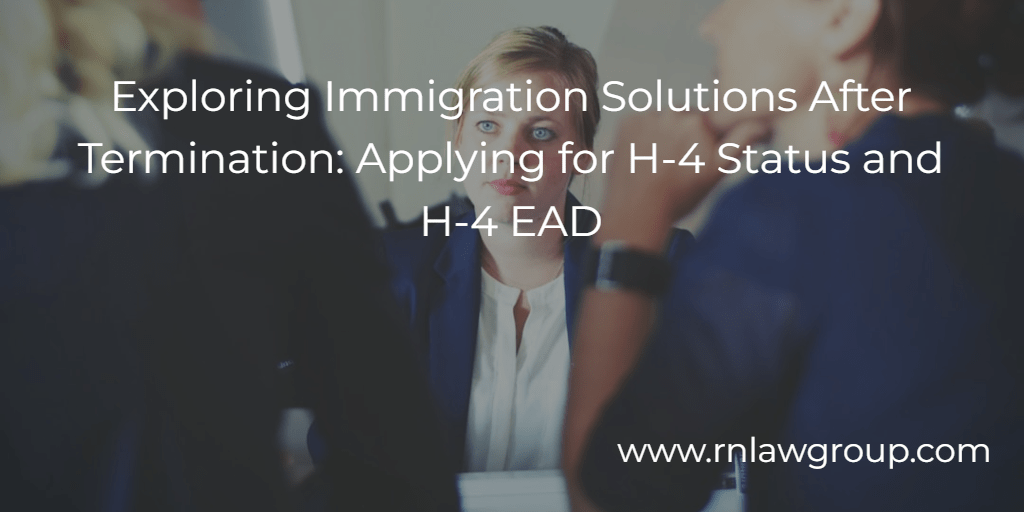
Exploring Immigration Solutions After Termination: Applying for H-4 Status and H-4 EAD
Navigating the maze of immigration options following termination is crucial for individuals seeking to maintain their status in the United States. In this detailed guide, we shift our focus to the process of applying for H-4 status and obtaining H-4 Employment Authorization Document (EAD) based on a spouse’s H-1B status and approved I-140. Whether you’re an employer looking to support departing employees or an individual seeking clarity on immigration pathways, understanding the intricacies of transitioning to H-4 status is essential. From eligibility criteria to documentation requirements, we’ll explore the steps involved in securing your legal status and facilitating a smooth transition during uncertain times.
Assessing Eligibility: Requirements for Changing to H-4 Status After Job Loss
Understanding the eligibility requirements is paramount for individuals aiming to transition to H-4 status following termination. To qualify, certain criteria must be met, including maintaining current nonimmigrant status, typically evidenced by an unexpired I-94 and recent pay statements. Applicants must also document their marriage to an H-1B holder by submitting a copy of the marriage certificate. It is also necessary to establish that the H-1B spouse is properly maintaining H-1B status. Additionally, evidence of the spouse’s approved I-140 petition is required to support the H-4 EAD application. While navigating post-termination complexities, showcasing sufficient ties to the home country is crucial to establish non-immigrant intent.
Leveraging the Grace Period: Filing for H-4 Status Before the Deadline
Submitting the necessary applications within the designated timeframe is critical for individuals navigating post-employment termination. The application for changing status to H-4 and obtaining H-4 EAD must be prepared meticulously and submitted to the United States Citizenship and Immigration Services (USCIS) before the expiration of the grace period following termination. Timing is crucial to ensure the success of the application. While receiving the receipt notice before the end of the grace period is not mandatory, timely and proper filing ensures eligibility for authorized stay in the United States.
Choosing Your Filing Method: Standalone or Concurrent
When considering the process of obtaining H-4 status and H-4 Employment Authorization Document (EAD) based on a spouse’s approved H-1B status, individuals have two primary options to explore. Firstly, they may choose to file standalone applications for H-4 status and H-4 EAD separately, based on the spouse’s already approved H-1B status. This approach allows for independent processing of the applications, potentially avoiding the necessity of involving the H-1B spouse’s employer in the process, but is subject to longer processing times and no option for premium processing. Alternatively, individuals can opt for concurrent filing of H-4 and H-4 EAD applications alongside their spouse’s H-1B renewal. By filing these applications concurrently, applicants can streamline the process and potentially minimize delays in obtaining both H-4 status and work authorization, especially with the ability to file in premium processing. Moreover, in cases where the spouse’s H-1B renewal is filed as an amendment plus extension, individuals can file more than 180 days before the current H-1B expires, providing additional flexibility and peace of mind regarding immigration status and employment authorization. Considering these options allows individuals to navigate the immigration process effectively, ensuring a smooth transition to H-4 status and facilitating access to employment opportunities under H-4 EAD.
Documenting Your Case: Essential Papers for H-4 Status Application Post-Termination
Assembling the required documentation is pivotal for a successful H-4 status application. Key documents include Form I-539 for changing status, accurately completed and signed, along with the appropriate filing fees. Supporting evidence such as passport bio-page copies, U.S. visas, I-94, I-797 approval notices, and recent pay statements are essential to demonstrate maintenance of status for the applicant. It is also necessary to document the spousal relationship through the marriage certificate. Lastly, the H-1B spouse must document maintenance of status by also providing evidence such as passport bio-page copies, U.S. visas, I-94, I-797 approval notices, and recent pay statements. The H-4 EAD application requires documentation of the H-1B spouse’s approved I-140 petition as well.
Exploring Employment Opportunities: Obtaining H-4 EAD During the Transition
If the applicant intends to work while on H-4 status, obtaining H-4 EAD is vital. USCIS typically processes concurrent decisions for H-4 status and H-4 EAD applications, and when filed concurrently with the spouse’s I-129 petition, premium processing can help ensure no undue delay in employment authorization. With the spouse’s approved I-140 petition, individuals can pursue employment opportunities without leaving the United States, facilitating a seamless transition back to the workforce.
In conclusion, navigating the immigration landscape post-termination requires careful planning and understanding of available options. By adhering to USCIS guidelines and assembling the necessary documentation, individuals can transition smoothly to H-4 status and pursue employment opportunities under H-4 EAD. By staying informed and seeking professional guidance when necessary, individuals can navigate post-termination immigration challenges with confidence and clarity.
By: Emily Neumann
Emily Neumann is Managing Partner at Reddy Neumann Brown PC with over 15 years of experience practicing US immigration law providing services to U.S. businesses and multinational corporations. Emily has helped transform the firm from a solo practice to Houston’s largest immigration law firm focused exclusively on U.S. employment-based immigration. She received her Bachelor’s degree in Biology from Central Michigan University and her Juris Doctorate degree from the University of Houston Law Center. Emily is a frequent speaker and has been quoted in Bloomberg Law, U.S. News & World Report, Inside Higher Ed, and The Times of India on various hot topics in immigration. She is a member of the American Immigration Lawyers Association and Society for Human Resource Management.
Reddy & Neumann has been serving the business community for over 25 years and is Houston’s largest immigration law firm focused solely on U.S. Employment-based immigration. We work with both employers and their employees, helping them navigate the immigration process quickly and cost-effectively.

